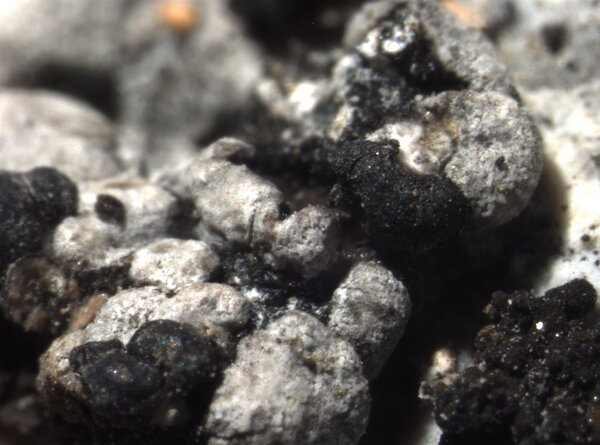Kiliasia nordlandica (Th.Fr.) Kistenich, Timdal, Bendiksby & S. Ekman
Taxon, 67: 892, 2018.. Basionym: Toninia nordlandica Th. Fr. - Lichenogr. Scand.: 339, 1874.
Synonyms: Kiliasia nordlandica (Th.Fr.) Kistenich, Timdal, Bendiksby & S.Ekman; Lecidea subrimulosa Nyl.; Toninia nordlandica Th. Fr.; Toninia steineri Poelt & Vězda; Toninia subrimulosa (Nyl.) Zahlbr.
Distribution: N - TAA, Lomb, Piem (TSB s.n.), VA (Piervittori & Isocrono 1999).
Description: Thallus squamulose or subsquamulose, consisting of scattered, to 1 cm wide clusters of squamules. Squamules up to 2(-3) mm in diam., rounded to irregularly lobed, convex, pale grey to white, sometimes with a brownish hue, weakly to moderately white-pruinose, smooth or shallowly fissured; lower surface pale brown. Upper cortex 25-60 mm thick, including a thick epinecral layer lacking crystals; algal layer continuous; medulla white, lacking crystals; lower cortex thin, partially absent. Apothecia lecideine, black, epruinose or sometimes faintly pruinose, up to 1(-1.5) mm across, soon becoming convex and immarginate. Proper exciple grey in outer part, colourless within, the pigmented parts K+ intensifying green, N+ purple-red, lacking crystals; epithecium grey, K+ and N+ violet; hymenium colourless, 40-60 µm high; paraphyses easily made free, 1.8-2.5 µm thick, the apical cells clavate, up to 8 µm wide, surrounded by a pigmented gel; hypothecium colourless. Asci 8-spored, clavate, surrounded by a gelatinous I+ blue coat, with a well-developed I+ blue tholus with a I+ darker blue tube and a well-developed ocular chamber, Bacidia-type. Ascospores 1-septate, hyaline, ellipsoid, 8.5-13 x 4-5 µm. Photobiont chlorococcoid. Spot tests: thallus K-, C-, KC-, P-, UV-. Chemistry: thallus without lichen substances; Sedifolia-grey pigment in apothecia.
Note: an arctic-alpine species found on steeply inclined to slightly rain-sheltered seepage tracks of calciferous or basic siliceous rocks, almost always on cyanobacterial colonies, or on thalli of Placynthium, at least when young, mostly in upland areas.
Growth form: Squamulose
Substrata: rocks
Photobiont: green algae other than Trentepohlia
Reproductive strategy: mainly sexual
On otherwise dry surfaces with short periods of water seepage after rain
paras Placynthium and cyanobactedial colonies
Commonnes-rarity: (info)
Alpine belt: very rare
Subalpine belt: rare
Oromediterranean belt: absent
Montane belt: very rare
Submediterranean belt: absent
Padanian area: absent
Humid submediterranean belt: absent
Humid mediterranean belt: absent
Dry mediterranean belt: absent

Predictive model
Herbarium samples
Growth form: Squamulose
Substrata: rocks
Photobiont: green algae other than Trentepohlia
Reproductive strategy: mainly sexual
On otherwise dry surfaces with short periods of water seepage after rain
paras Placynthium and cyanobactedial colonies
Commonnes-rarity: (info)
Alpine belt: very rare
Subalpine belt: rare
Oromediterranean belt: absent
Montane belt: very rare
Submediterranean belt: absent
Padanian area: absent
Humid submediterranean belt: absent
Humid mediterranean belt: absent
Dry mediterranean belt: absent

Predictive model
| Herbarium samples |
 Index Fungorum
Index Fungorum
 GBIF
GBIF







